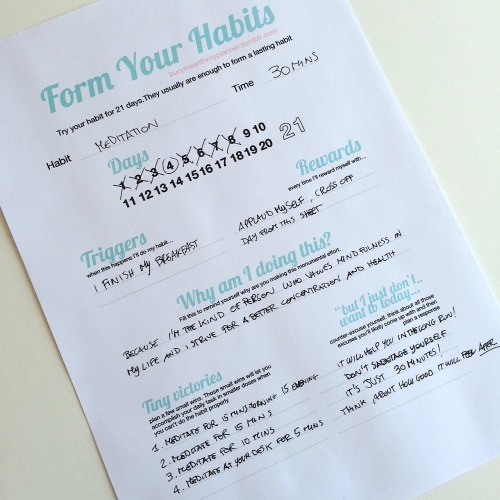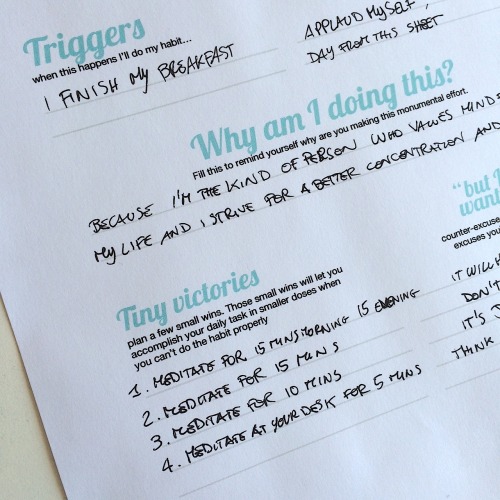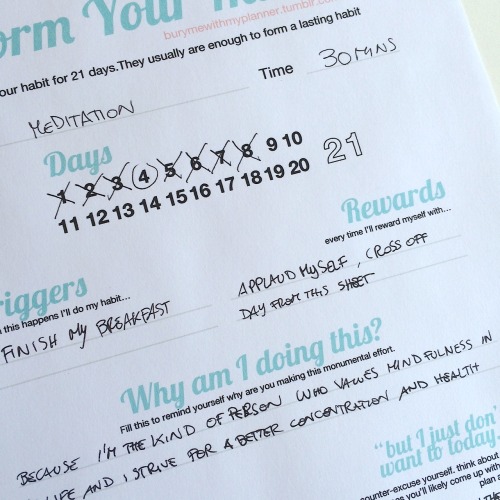Form Your Habits



Form your habits
free printable you can download here
Forming your habits can be extremely difficult, here’s a tool that can help you achieve that. I use a 21 days calendar because it’s customary in these sort of things. It’s not scientifically based but usually 21 days are enough for most people to create a new lasting habit. Sometimes you’ll need more.
All the sections in the printable are there to help you, so I really recommend you fill every part! Let’s see what those are:
Triggers - it can be anything, even an alarm on your phone, but I suggest you ‘latch’ your new habit to some old one you have. Like if you want to start flossing, use as a trigger ‘after washing my teeth’ or something logical like that. Also put this printable somewhere you can see, so that you’ll be reminded of it!
Rewards - while the habit in itself should be a reward you definitely need something a little more short term because sometimes it’s difficult to see the long term plan. Something small and easy, like congratulating yourself, or crossing off the task in your planner or app, or buy something small like a song or an app, or do a little dance or whatever it might work for you and might bring a smile on your face.
Why am I doing this? - This is possibly the most important. if you don’t have a personal reason to form a new habit you’ll never find the motivation to do it.
Tiny Victories - More often than not you’ll face all sort of obstacles during your attempt to form your habit. Consider from the beginning a list of small wins that are a ‘lighter version’ of your habit. So you don’t have to punish yourself if you don’t get that day to perform your habit. It will make it easier for you to start the habit and it will not become a chore.
“but I just don’t want to today…” - We are our worst enemies. You know yourselves pretty well, you probably have tried more than once to attempt this habit, so you know how many excuses you can come up in the next 21 days to avoid working on your habit… “I’m too stressed to do this” “I was so good yesterday I can take a day off” “I’m on vacation”… and so on. Make a list of replies to yourself, now that your excitement is at the top so in the next days you’ll be able to read it again and convince yourself to actually do what you proposed yourself to do.
Here’s a list of good habits you might want to try:
daily review of your planner
cleanup your desk
meditate
take a walk
exercise for 30 minutes
15 minutes of gesture drawing
wake up early
work 30 minutes on your personal project
use a language app
write in your journal
clean something
drink enough water
-
 darkleylines liked this · 1 year ago
darkleylines liked this · 1 year ago -
 dawnisanillusion liked this · 1 year ago
dawnisanillusion liked this · 1 year ago -
 ghcstflowcr liked this · 1 year ago
ghcstflowcr liked this · 1 year ago -
 kallypsos liked this · 1 year ago
kallypsos liked this · 1 year ago -
 heartstringsduet liked this · 2 years ago
heartstringsduet liked this · 2 years ago -
 gummybaby liked this · 2 years ago
gummybaby liked this · 2 years ago -
 owlsandomens reblogged this · 2 years ago
owlsandomens reblogged this · 2 years ago -
 bugsupport liked this · 2 years ago
bugsupport liked this · 2 years ago -
 ourselvesnimortality liked this · 2 years ago
ourselvesnimortality liked this · 2 years ago -
 lireb-librarian liked this · 3 years ago
lireb-librarian liked this · 3 years ago -
 sunsmudge-peachmoon liked this · 3 years ago
sunsmudge-peachmoon liked this · 3 years ago -
 florestnimphy liked this · 3 years ago
florestnimphy liked this · 3 years ago -
 letsxxnourish2flourishxxus reblogged this · 3 years ago
letsxxnourish2flourishxxus reblogged this · 3 years ago -
 letsxxnourish2flourishxxus reblogged this · 3 years ago
letsxxnourish2flourishxxus reblogged this · 3 years ago -
 afk-brb liked this · 3 years ago
afk-brb liked this · 3 years ago -
 petrichor-and-fire liked this · 3 years ago
petrichor-and-fire liked this · 3 years ago -
 un-idyllic liked this · 3 years ago
un-idyllic liked this · 3 years ago -
 ririsingstar reblogged this · 4 years ago
ririsingstar reblogged this · 4 years ago -
 ririsingstar liked this · 4 years ago
ririsingstar liked this · 4 years ago -
 lyralibra reblogged this · 4 years ago
lyralibra reblogged this · 4 years ago -
 learningtorecognize reblogged this · 4 years ago
learningtorecognize reblogged this · 4 years ago -
 dopesuitcasehumandiplomat liked this · 4 years ago
dopesuitcasehumandiplomat liked this · 4 years ago -
 wakeupyounggirl reblogged this · 4 years ago
wakeupyounggirl reblogged this · 4 years ago -
 milywolfhard liked this · 4 years ago
milywolfhard liked this · 4 years ago -
 daughterdiaspora reblogged this · 4 years ago
daughterdiaspora reblogged this · 4 years ago -
 theebonygeisha liked this · 4 years ago
theebonygeisha liked this · 4 years ago -
 lawoyin liked this · 4 years ago
lawoyin liked this · 4 years ago -
 uni-chan06 liked this · 4 years ago
uni-chan06 liked this · 4 years ago -
 ghettochique reblogged this · 4 years ago
ghettochique reblogged this · 4 years ago -
 captainphantasmic liked this · 5 years ago
captainphantasmic liked this · 5 years ago -
 ghettochique liked this · 5 years ago
ghettochique liked this · 5 years ago -
 reasons--i-cry reblogged this · 5 years ago
reasons--i-cry reblogged this · 5 years ago -
 strawberryashcakes liked this · 5 years ago
strawberryashcakes liked this · 5 years ago -
 afortioriadaugusta liked this · 5 years ago
afortioriadaugusta liked this · 5 years ago
More Posts from Jorgefg89



vix @cofene’s daily planner printables
brand new baby studyblr here! after finally deciding to start up this blog i suddenly got really excited and made daily planners… it is full of all of the things i personally find useful but i’ve attached download links in case you like it! i was especially inspired (both to create this blog and to design these printables) by @cmpsbls, @studeying, and @gryfhindor. thank you!
download: [color] [b&w]
Estudiar medicina no es difícil.
Ya me ha tocado escuchar a chicos de la facultad quejarse de lo “pesado” que es la carrera, por lo general son los de nuevo ingreso, aunque también me ha tocado la pregunta del millón: ¿Y está muy difícil la carrera?.
Lo cierto es que no. Medicina no es difícil, todo es cuestión de prioridades y organización. En estos últimos dos años he aprendido algunas cosas que hoy les comparto..
Seguir leyendo
Tejido epitelial.
El tejido epitelial son un grupo de células estrechamente unidas que recubren las superficies del cuerpo y revisten las cavidades internas (Aparato cardiocirculatorio) y los tubos que comunican con el exterior (Aparato gastrointestinal, respiratorio y genitourinario). El epitelio crea una barrera selectiva entre el medio externo y el tejido conjuntivo subyacente. Los epitelios tienen una región apical, que es la más superficial, y una región basar, la más interna. Entre sus funciones tenemos:
Protección de los tejidos subyacentes del cuerpo.
Transporte celular moléculas a través de las capas epiteliales.
Secreción de moco, hormonas, enzimas, etc.
Absorción de material de una luz (Ej: túbulos renales, tubo digestivo)
Clasificación de los epitelios.

Los epitelios pueden clasificarse según la forma de las células en escamoso o plano, cúbico o cuboidal y cilíndrico.


O por la cantidad de capas de células en simple y estratificado.


Tejido epitelial plano simple: células delgadas cuyo ancho es mayor a la altura, este epitelio se encuentra en los alveolos pulmonares, los vasos sanguíneos y linfáticos, la capsula de Bowman y el revestimiento de la cornea. Si reviste cavidades cerradas (Cavidad pleural, pericardica o del tracto intestinal) recibe el nombre de mesotelio, si reviste vasos sanguíneos endotelio.

Tejido epitelial cúbico simple: células cuyo ancho, alto y profundidad son más o menos iguales tiene funciones de absorción y protección y se encuentra en el riñón, la cubierta externa del ovario y los conductos de glándulas exocrinas.

Tejido epitelial cilíndrico simple: células cuya altura es apreciablemente mayor al ancho y la profundidad. Cumple funciones de absorción y secreción, sus células poseen abundante citoplasma y lo encontramos en los conductos colectores del riñón y la cubierta interna del estómago.

Tejido epitelial plano estratificado no queratinizado: formado por varias capas de células aplanadas. Tiene función de protección y se encuentra en mucosas con desgaste como vagina, cavidad oral, esófago.

Tejido epitelial plano estratificado queratinizado: formado por capas de células planas recubiertas por una densa capa de queratina. Tiene funciones de protección y lo encontramos en toda la epidermis.

Tejido epitelial cúbico estratificado: formado por capas de células cúbicas tiene función de conducción, de absorción, de secreción y de barrera. Se encuentra en el conducto de las glándulas sudoríparas y en la unión anorrectal.


Tejido epitetelial cilíndrico estratificado: formado por capas de células cilíndricas y cúbicas tiene funciones de conducción, de secreción, de absorción y de protección. Se encuentra en los conductos de las glándulas exocrinas y en la unión anorrectal.

Tejido epitelial cilíndrico pseudoestratificado: en éste epitelio todas las células están sobre la lámina basal pero todas no llegan a la superficie dando un aspecto estratificado son estarlo. Tiene funciones de secreción, absorción, lubricación, protección, transporte y conducción. Lo encontramos en la traquea y el árbol bronquial, el conducto deferente, los conductilllos eferentes del epididimo, la trompa auditiva, la cavidad timpánica, el saco lagrimal y los conductos excretores del escroto.


Tejido epitelial de transición o urotelio: tiene dos formas, una cupular y una aplanada, tiene funciones de protección y de distensibilidad. Se encuentra en los cálices renales, los úreteres, la vejiga y la uretra.
La región apical del tejido epitelial puede sufrir ciertas modificaciones que le permiten desempeñar funciones específicas al epitelio, entre éstas tenemos:
Microvellosidades: prolongaciones citoplasmáticas que se extienden hacia la superficie celular.
Estereocilios: microvellosidades de gran longitud.

Cilios: prolongaciones citoplasmáticas móviles. Cilios en el intestino.




Sarah’s / @studeying To Do List Printables #2 version ~
aesthetic-empire requested for some woody / earthy / guy colours so I’ve just tweaked the colours of my newest to do printables! Hope these are ok haha. ://
the original to do printables + my other printables
download links: (left to right, up to down)
[ one | two | three | four }
+ please feel free to ask me for other colour variations ! Also please tag me with #studeying so I can check out your stuff hi
Thank you!
